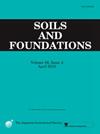Bioremediation for seleno-oxyanions in tunnel-excavated muck using selenate-reducing bacterium Stutzerimonas stutzeri NT-I
IF 3.3
2区 工程技术
Q2 ENGINEERING, GEOLOGICAL
引用次数: 0
Abstract
Selenium is a rare metal found mainly in volcanic sediments; it is naturally distributed in Japan owing to its sulfide deposits. Selenium exists in soil as highly toxic and soluble seleno-oxyanions, namely, selenate and selenite. The Japanese government has established standards for soluble selenium concentrations in soil, achieved by water shielding or the addition of insolubilization agents. If the selenium (and/or other heavy metals) in tunnel-excavated muck exceeds the environmental standards, it should be treated similarly to contaminated soil. However, conventional treatments leave selenium residues in tunnel-excavated muck, preventing their reuse due to the risk of selenium re-elution. This study attempted to insolubilize soluble seleno-oxyanions in tunnel-excavated muck by adding the bacterium Stutzerimonas stutzeri NT-I, which reduces selenate to insoluble elemental selenium and then to volatile dimethyl diselenide. Selenate reduction tests were conducted by adding heavy metals, including As(III), As(V), Cd(II), Pb(II), and Fe(III), to examine the selenate reduction ability and growth of S. stutzeri NT-I in the presence of their ions. The results showed that the S. stutzeri NT-I reduced the selenate by 50 mg/L concentrations for all the tested contaminants. In naturally contaminated tunnel-excavated muck, heavy metal elements, nitrate, and nitrite contents were detected at levels of <50 mg/L, suggesting that they do not adversely affect the selenate reduction by S. stutzeri NT-I. The results indicate that selenium insolubilization using S. stutzeri NT-I can be applied to a wide range of tunnel-excavated muck.
利用硒还原菌Stutzerimonas stutzeri NT-I对隧道开挖淤泥中硒氧阴离子进行生物修复
硒是一种稀有金属,主要存在于火山沉积物中;由于其硫化物矿床,它在日本自然分布。硒在土壤中以高毒性和可溶性的硒氧离子存在,即硒酸盐和亚硒酸盐。日本政府已经建立了土壤中可溶性硒浓度的标准,通过水屏蔽或添加不溶剂来实现。如果隧道开挖淤泥中的硒(和/或其他重金属)超过环境标准,则应将其与受污染的土壤类似处理。然而,传统的处理方法将硒残留在隧道开挖的淤泥中,由于硒的再洗脱风险,使其无法再利用。本研究试图通过添加Stutzerimonas stutzeri NT-I细菌,使隧道开挖淤泥中的可溶性硒氧阴离子失溶,将硒酸盐还原为不溶性元素硒,然后转化为挥发性二甲基二硒化物。通过添加As(III)、As(V)、Cd(II)、Pb(II)和Fe(III)等重金属进行硒酸盐还原试验,考察S. stutzeri NT-I在其离子存在下的硒酸盐还原能力和生长情况。结果表明,S. stutzeri NT-I对所有被测污染物的硒酸盐浓度降低了50 mg/L。在自然污染的隧道开挖淤泥中,重金属元素、硝酸盐和亚硝酸盐含量在50 mg/L的水平下被检测到,这表明它们不会对S. stutzeri NT-I还原硒酸盐产生不利影响。结果表明,S. stutzeri NT-I对硒的不溶化作用可广泛应用于隧道开挖的淤泥中。
本文章由计算机程序翻译,如有差异,请以英文原文为准。
求助全文
约1分钟内获得全文
求助全文
来源期刊

Soils and Foundations
工程技术-地球科学综合
CiteScore
6.40
自引率
8.10%
发文量
99
审稿时长
5 months
期刊介绍:
Soils and Foundations is one of the leading journals in the field of soil mechanics and geotechnical engineering. It is the official journal of the Japanese Geotechnical Society (JGS)., The journal publishes a variety of original research paper, technical reports, technical notes, as well as the state-of-the-art reports upon invitation by the Editor, in the fields of soil and rock mechanics, geotechnical engineering, and environmental geotechnics. Since the publication of Volume 1, No.1 issue in June 1960, Soils and Foundations will celebrate the 60th anniversary in the year of 2020.
Soils and Foundations welcomes theoretical as well as practical work associated with the aforementioned field(s). Case studies that describe the original and interdisciplinary work applicable to geotechnical engineering are particularly encouraged. Discussions to each of the published articles are also welcomed in order to provide an avenue in which opinions of peers may be fed back or exchanged. In providing latest expertise on a specific topic, one issue out of six per year on average was allocated to include selected papers from the International Symposia which were held in Japan as well as overseas.
 求助内容:
求助内容: 应助结果提醒方式:
应助结果提醒方式:


